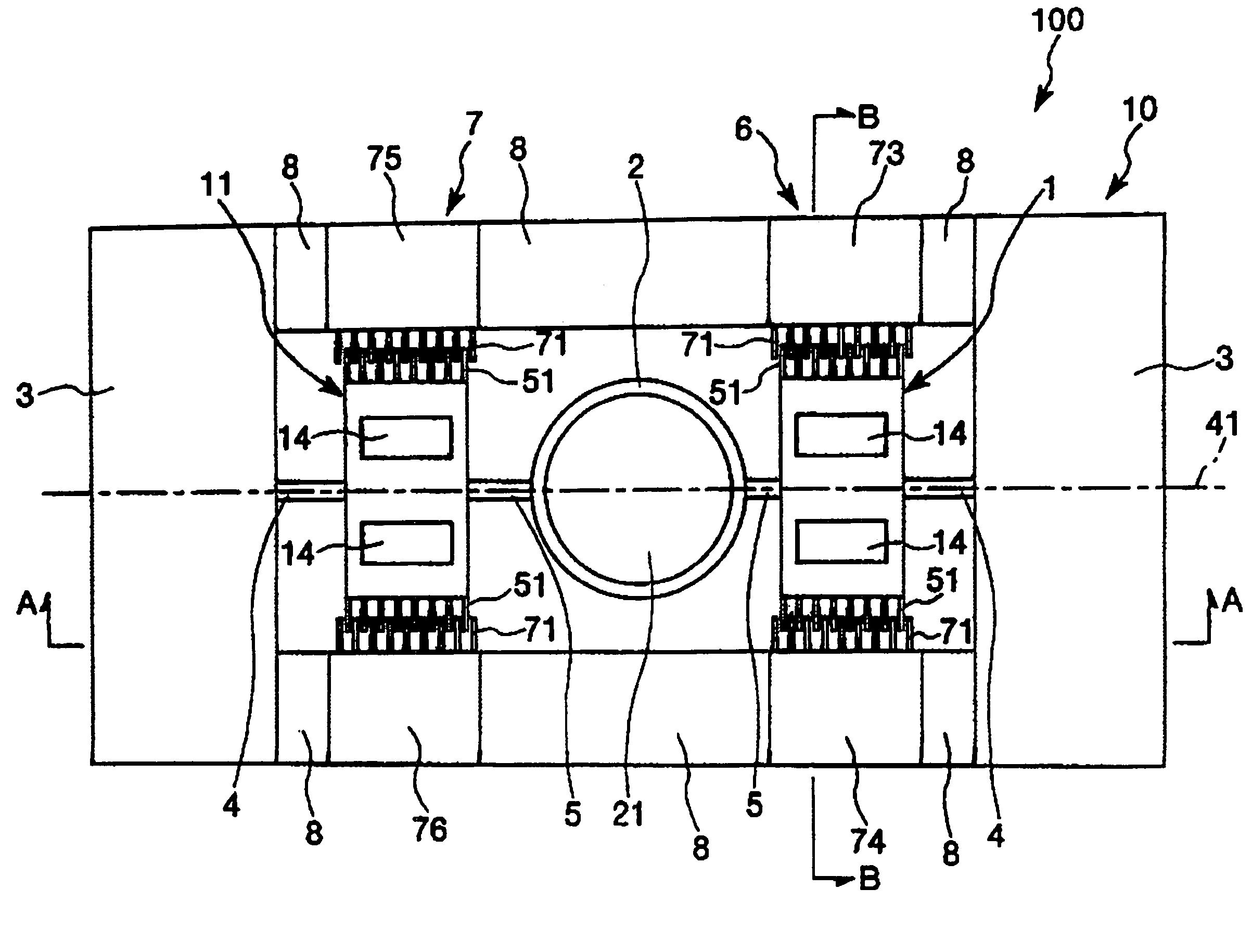Actuator
a technology of actuators and actuators, applied in the field of actuators, can solve the problems of increasing manufacturing costs, difficult to rotate the polygon mirror at a much higher speed, and difficulty in miniaturizing the size of the apparatus in which the polygon mirror is used, and achieve the effect of large torqu
- Summary
- Abstract
- Description
- Claims
- Application Information
AI Technical Summary
Benefits of technology
Problems solved by technology
Method used
Image
Examples
first embodiment
[0079]First, a first embodiment of the actuator according to the invention will be described. FIG. 1 is a plan view which shows a first embodiment of the actuator according to the invention. FIG. 2 is a cross-sectional view taken along line A-A in FIG. 1. FIG. 3 is a cross-sectional view taken along line B-B in FIG. 1. In the following description using FIG. 1, for convenience of description, it is to be noted that the upper side, the lower side, the right side and the left side in FIG. 1 will be referred to as the “upper side”, “lower side”, “right side” and the “left side”, respectively.
[0080]As shown in FIGS. 1 and 2, an actuator 100 includes: a pair of movable comb electrodes (first mass portions) 1 and 11; a movable portion (second mass portion) 2; a pair of supporting portions 3 for supporting the movable portion 2 and the movable comb electrodes 1, 11; four fixed comb electrodes 73, 74, 75 and 76 provided so as to correspond to the pair of movable comb electrodes 1, 11; and a...
second embodiment
[0153]Next, a second embodiment of the actuator according to the invention will be described. FIG. 8 is a plan view which shows the second embodiment of the actuator according to the present invention. Hereinafter, an actuator 100 shown in FIG. 8 will be described by focusing on the difference between the first and second embodiments, and therefore a description of the same points will be omitted.
[0154]As shown in FIG. 8, the actuator 100 of the present embodiment includes two pairs of first elastic connecting portions 4′, 4′, and two pairs of second elastic connecting portions 5′, 5′. The two pairs of first elastic connecting portions 4′, 4′ connect the movable comb electrodes 1, 11 to the supporting portions 3, 3, respectively, so that each of the movable comb electrodes 1, 11 can rotate with respect to the corresponding supporting portion 3. The two pairs of second elastic connecting portions 5′, 5′ connect the movable portion 2 to the movable comb electrodes 1, 11, respectively,...
third embodiment
[0156]Next, a third embodiment of the actuator according to the invention will be described. FIG. 9 is a plan view which shows the third embodiment of the actuator according to the present invention. Hereinafter, an actuator 100 shown in FIG. 9 will be described by focusing on the difference between the first and third embodiments, and therefore a description of the same points will be omitted. In the actuator 100 of the present embodiment, one movable comb electrode 111 is formed around a movable portion 2 in a circular manner. In other words, the movable comb electrode 111 is constructed from a electrode base and a plurality of first electrode teeth 51, and an opening 112 is provided in the movable comb electrode 111 at the center portion thereof. The movable portion 2 is provided within the opening 112 of the movable comb electrode 111.
[0157]With such a structure, the actuator 100 can have a more stable structure. Further, in the present embodiment, the fixed comb electrode 73 an...
PUM
 Login to View More
Login to View More Abstract
Description
Claims
Application Information
 Login to View More
Login to View More - R&D
- Intellectual Property
- Life Sciences
- Materials
- Tech Scout
- Unparalleled Data Quality
- Higher Quality Content
- 60% Fewer Hallucinations
Browse by: Latest US Patents, China's latest patents, Technical Efficacy Thesaurus, Application Domain, Technology Topic, Popular Technical Reports.
© 2025 PatSnap. All rights reserved.Legal|Privacy policy|Modern Slavery Act Transparency Statement|Sitemap|About US| Contact US: help@patsnap.com



